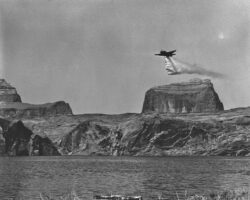Many high mountain lakes are being targeted for annual aerial fish stockings. These lakes are perfect, cold environments for trout, and other species to thrive. These lakes are also remote and have limited access. The only way to stock these lakes is with creative transports.
Back in the early days, mules carried milk cans filed with fingerlings along remote trails. The 1–3-inch fry were dumped into ponds and watersheds that had few or no fish. I remember hauling a backpack, full of small trout to stock in remote areas. The hike back to the truck was always easier. Folks do not realize that over 60% of the waters in Yellowstone Park were virgin of fish.
These stocked fish ultimately became Wild, reproducing populations. In the early days, fish were stocked without much thought to species and ecosystems. If it swam, it was stocked. After WW2, vintage military aircraft were used to release fish. On some lakes, a plan could land, or at least make a Bombs Away fly over. The Grumman Duck and TBF Torpedo bomber were great for this job.
More modern aircraft, and helicopters are retrofitted to stock small fish today. A small plane can carry over 25,000 fry, in one trip, and stock multiple watersheds. Planes need to get slow and low to ensure survival of the fish fry. The small fish flutter like wet leaves, which limits impact. 95-99% of aerial stocked fish survive. Flying fish are airborne for just moments before splashing into their new homes.
Horses, trucks, atvs, and other creative transport are used to stock remote watersheds. Long hoses can be laid out to slide fish into off road areas. Remote fisheries are usually stocked with fingerlings and are left to grow and fatten up on their own. This is a healthy, and cost savings, way to repopulate fisheries.
Stocked watersheds and ponds are closely monitored to see growth rate, water conditions, and health. If the are becomes too warm or low, stocking is halted. Many lakes are put on a multiple year plan and stocked only periodically. This is determined by fishing pressure and growth rate of the fishery. More heavily fished areas are stocked more often.
You can go to your states Fishery website to research where, when, and how your remote fisheries are stocked.
Bail Out for some great fishing!
Montana Grant